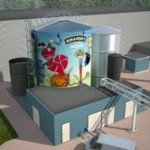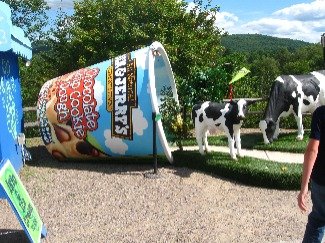 An anaerobic digestion process is now being used on effluent from ice-cream. Unilever’s Ben & Jerry's ice cream factory in Holland is deriving green energy from wastewater with a new Anaerobic Digestion Plant installation by the Dutch-based Anaerobic Digestion technology expert, Paques.
An anaerobic digestion process is now being used on effluent from ice-cream. Unilever’s Ben & Jerry's ice cream factory in Holland is deriving green energy from wastewater with a new Anaerobic Digestion Plant installation by the Dutch-based Anaerobic Digestion technology expert, Paques.
Unilever, together with Paques, has started (in 2010) the construction of a bio-digester at its Ben & Jerry’s ice cream factory in Hellendoorn, the Netherlands. The bio-digestion process is unique.
Anaerobic Digestion Process Used on Effluent:
Waste Products Released During the production of Ice-Cream are Converted Into Energy

Instead of needing large amounts of energy to run the process, the waste products that are released during the production of ice-cream will be converted into energy.
Furthermore, this is energy that will not add to global warming and when, as here, it replaces the use of fossil fuel-based oil, it helps to reduce carbon dioxide emissions and climate change.
The bio-digester using the Paques patent design will provide 40% of the ice cream factory’s energy requirements.
It has also been pointed out that Unilever has a “Sustainable Living Plan”. Just like many other big companies, tasked by the government to join in with reducing the impact of industry on the environment, this is aimed at reducing the production of company-wide waste. The AD Plant does that very well. It lowers the company's consumption of both water and energy.
They predicted (in 2010) that the bio-digester will become operational in mid-2011, after a commissioning period.
Paques BIOPAQ®AFR
Unilever has opted for a new type of bio-digester offered by Paques. It is called the BIOPAQ®AFR.
They report that the idea of the BIOPAQ®AFR is that natural micro-organisms (in this case more than 24 billion of these little bugs) will ‘eat‘ the waste products in the factory water. This results in discharges that are far less potentially damaging than the incoming untreated effluent. In addition, biogas is produced at the same time. Biogas contains methane gas and usually more than half is methane gas.
The wastewater is purified by converting the waste products from ice cream production such as milk, cream, proteins, syrups, and pieces of fruit, into biogas.
We are told that the BIOPAQ®AFR is a new development in the field of purification of fat-containing wastewater. Their neat act is that they will treat (digest) wastewater streams that contain fat and oil in one compact reactor, together with degradable solid particles.
Paques tell us that in conventional systems this is only possible by going through a number of processing stages.
The construction of the bio-digester is well underway having started in Autumn 2010, and Unilever is leading the technology, being one of the first companies worldwide to buy such a methane bio-digester.
Paques’ anaerobic water purification systems are said to produce energy from wastewater, whilst at the same time purifying the water and facilitating water reuse.
The biogas is to be produced in the purifying process is a source of green energy. Since the introduction of their first BIOPAQ® reactor in 1981, they say that through their close co-operation with their partners they have been able to develop a broad portfolio for integrated water and gas treatment. They describe Paques’ technologies as, not only inherently green but also proven to be cost-effective and reliable solutions.
Further Reading About the Anaerobic Digestion Process:
 The BIOPAQ®IC technology is a proven technology that is recognized worldwide as the most efficient way to clean industrial wastewater and produce biogas at the same time. BIOPAQ®ICX, a new development in the BIOPAQ® product line, was designed by Paques in order to meet today’s customer’s requirements.
The BIOPAQ®IC technology is a proven technology that is recognized worldwide as the most efficient way to clean industrial wastewater and produce biogas at the same time. BIOPAQ®ICX, a new development in the BIOPAQ® product line, was designed by Paques in order to meet today’s customer’s requirements.
BIOPAQ®ICX combines the excellent properties of the BIOPAQ®IC reactor with high flexibility with regard to tank design. The compact system is even implementable in existing tanks. Due to high overall biomass levels and concentration, the system can deal with high volumetric loading rates. The 2-stage biomass retention prevents wash-out of biomass and high liquid velocities and high excellent mixing properties enable the process to handle a wide range of industrial wastewater.
Having over 30 years of experience, more than 1000 references in wastewater treatment plants, and more than 180 references in biogas purification systems, Paques is able to provide every industry/ municipality with a tailor-made wastewater treatment system. via www.environmental-expert.com
High rate Internal Circulation (IC) Bioreactors
With the development of high rate Internal Circulation (IC) bioreactors, Paques made a break-through in anaerobic wastewater treatment. The internal circulation provides excellent mixing of the biomass with the influent is self-regulating with the incoming COD-load. It can, therefore, deal with high loading rates in a very compact reactor. In addition, both noise and odour issues have been addressed.
BIOPAQ®IC bioreactors have become a proven technology, with hundreds of examples worldwide in various industrial sectors. A complete range of BIOPAQ®IC models is available through a worldwide network of licensees. via www.betterworldsolutions.eu
Upflow Anaerobic Sludge Blanket (UASB) Process Also Offered
The Upflow Anaerobic Sludge Blanket (UASB) process is a frequently applied method in the biological treatment of industrial effluents. Paques has applied the BIOPAQ®UASB technology for more than twenty years and has standardized the reactor into a modular system.
Nearly four thousand BIOPAQ® modules are in operation worldwide, treating 1,760,000 m3 of effluent per day. One module has a capacity equivalent to about 1 tonne COD/day (e.g. This modular approach allows us to configure any specific layout and capacity requirement.
BIOPAQ®UASB technology is applied to treat a large variety of industrial and municipal effluents from food, beer, and beverage to pulp and paper, chemical, and municipal sewage. The modules are available through a worldwide network of licensees. Additionally, a retrofit programme is available for existing UASB installations. Paques not only has a lot of experience in updating Paques’ installations but also in improving products of other suppliers. via www.environmental-expert.com
Cleaner paper production in DS Smith Kemsley Paper Mill thanks to 1500th Paques BIOPAQ® reactor
1500th Paques Anaerobic Digestion Process Used on Effluent at the UK’s Largest Paper Recycling Mill
(Tuesday 29/10/2019) – Paques is proud to inform you that we have installed our 1500th BIOPAQ reactor at the DS Smith Kemsley Paper Mill in the United Kingdom. Paques is the global leader in biological wastewater and gas treatments and has realized more than 3,000 reference installations worldwide of which 1500 are anaerobic BIOPAQ reactors.
Kemsley Mill is the UK’s largest paper recycling mill, and the second largest in Europe, producing over 800,000 tonnes of paper every year. Kemsley processes recycled paper into new papers for packaging and construction. The mill’s sustainability developments, including the on-site anaerobic digestion plant, energy from waste facility, and the preparations for a new CHP plant, ensure that the mill is becoming more energy-efficient. This is in line with the DS Smith Group’s target to reduce its CO2 emissions by 30% per tonne of production by 2030. via https://de.paques.nl/news/news



